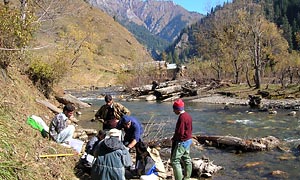The restoration of native cutthroat trout to an important tributary stream
Date:
2001 - 2021
Abstract:
While the importance of reducing impacts of nonnative species is increasingly recognized in conservation, the feasibility of such actions is highly dependent upon several key uncertainties including stage of invasion, size of the ecosystem being restored, and magnitude of the restoration activity. We have been evaluating nonnative brown trout removal and the response by native Bonneville cutthroat trout to this removal in a small tributary (Right Hand Fork) in the Intermountain West. We monitored trout for 10 years prior to the onset of eradication efforts, which included 2 years of mechanical removal followed by 2 years of chemical treatment. Cutthroat trout were then seeded with low numbers of both eggs and juvenile trout. We monitored demographics and estimated population growth rates and carrying capacities for cutthroat trout from long-term depletion estimate data, assuming logistic population growth. Following brown trout eradication and initial seeding efforts, cutthroat trout have responded rapidly and have approached their estimated carrying capacity within 6 years. Population projections suggest a 95% probability that cutthroat trout will be at or above 90% of their carrying capacity within 10 years of the eradication of brown trout. Additionally, at least four age-classes are present including adults large enough to satisfy angling demand. These results demonstrate native trout species have substantial capacity to rapidly recover following removal of invasive species in otherwise minimally altered habitats. While tributaries such as like this study location are likely limited in extent individually, collectively they may serve such as source populations for larger connected systems.
Funding:
- Utah Division of Wildlife Resources
- U.S. Forest Service, Rocky Mountain Research Station
- Trout Unlimited – Cache Anglers
- U.S. Geological Survey Utah Cooperative Fish and Wildlife Research Unit (in-kind)
- The Ecology Center at Utah State University
Investigators:
- Dr. Phaedra Budy, U.S. Geological Survey – UCFWRU, Dept. of Watershed Sciences, USU
- Dr. Tim Walsworth, Dept. of Watershed Sciences, USU
- Gary P. Thiede, Dept. of Watershed Sciences, USU
Other Collaborators:
- Paul Thompson, Utah Dept. of Natural Resources
- Matt McKell, Utah Division of Wildlife Resources
- Paul Chase, US Forest Service
- Paul Holden, Trout Unlimited, Cache Anglers chapter

Three age classes of native Bonneville Cutthroat trout from Right Hand Fork, Logan River Watershed just four years after brown trout removal. Photo Credit, Gary Thiede.


